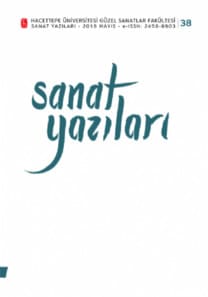MEKAN VE TARIM İLİŞKİSİ: H.Ü. (BEYTEPE) KENT TARIMI PROJESİ
Kent tarımı yerel ölçekte toplumun gıda ihtiyaçlarını karşılamanın yanı sıra, çevresel sürdürülebilirlik, sağlık, beslenme ve sosyal etkileşim gibi farklı boyutlarda pozitif etkilere sahiptir. Yaşam alanlarımız olan iç mekanlarda ve kent merkezlerinde yenilebilir yeşil alanların oluşturulması, sürdürülebilir kalkınma ve tarımın hem bireysel hem de toplumsal amaç haline gelmesini mümkün kılacaktır. Bu perspektife dayanarak Hacettepe Üniversitesi Beytepe Kampüsünde oluşturulmuş olan tarım alanları hem yeşil kampüs olma yolunda bir çalışma hem de kampüs kullanıcıları yönünde kolektif bir yaşam komünü oluşturma yapısı sergilemektedir. Sağlıklı gıdaya erişim, çevre bilinci ve kent-kırsal diyalektiğini ‘çoğulculuk’ felsefesi ile çözümlemek ve sentezlemek bu projenin temel hedeflerindendir. Bu çalışmanın amacı Ankara kentinin zorlu topoğrafyası ve mikroikliminde, sürdürülebilir hedefler çerçevesinde, Hacettepe Üniversitesi Beytepe Kampüs Tarımı Projesi’nin analizini yapmaktır
THE RELATIONSHIP OF SPACE AND AGRICULTURE: H.U. (BEYTEPE) URBAN AGRICULTURE PROJECT
In addition to meeting the food needs of the society at the local scale, urban agriculture has positive effects in different aspects such as environmental sustainability, health, nutrition and social interaction. Creating renewable green areas in interiors and city centers will make it possible for sustainable development and agriculture to become both individual and social goals. Based on this perspective, the agricultural area established on the Beytepe campus of Hacettepe University demonstrates both a work towards becoming a green campus and a collective life commune structure towards the users of the campus. One of the main objectives of this project is to analyze and synthesize access to healthy food, environmental awareness and urban-rural dialectics with the philosophy of ‘pluralism’. In this regard, The aim of this study is to analyze the Beytepe Campus Agriculture Project in Hacettepe University in the challenging topography and microclimate of Ankara city, within the framework of sustainable goals.
___
- Berney, Rachel. (2010). Learning from Bogota: how municipal experts transformed public space. J. Urban Des, cilt:15/sayı:4, s.. 539-558.
- Bolund, P., Hunhammar, S. (1999). Ecosystem services in urban areas. Ecological Economics, sayı.29, s. 293-301.
- Chiesura, Anna. (2004). The role of urban parks for the sustainable city. Landscape Urban Planning, cilt.68/sayı.1, s. 129-138.
- FAO. (2015). Promote sustainable management of soil resources for soil protection, conservation and sustainable productivity. Erişim:14.05.2022 http://www.fao.org/3/ CA2217EN/ca2217en.pdf
- FAO. (2016). Status of the World’s Soil Resources. Technical Summary. Erişim: 14.05.2022 http://www.fao.org/3/a-i5126e.pdf
- Fleury, A., A. Ba. (2005). Multifunctionality and Sustainability of Urban Agriculture. Urban Agriculture Magazine. Sayı: 15.
- Hodgson, K., Campbell, M. C.,Bailkey, M. (2010). Urban Agriculture: Growing healthy, sustainable communities. American Planning Association Report. .sayı:563
- Huang, Shu-Chun Lucy. (2006). A study in outdoor interactional spaces in high-rise housing. Landscape Urban Planning, sayı.78, s. 193-204.
- Kabisch, Nadja. (2016). Ecosystem service implementation and governance challenges in urban green space planning—The case of Berlin, Germany. Land Use Policy, sayı.42, s.557-567
- Kázmierczak, Aleksandra. (2013). The contribution of local parks to neighbourhood social ties. Landscape Urban Planning, 109 (2013), pp. 31-44
- Kellert, R. S., Wilson, E. O. (1993). Biophilia hypothesis. Washington, DC: Island Press.
- Mougeot, Luc J.A. (2000). Urban agriculture: definition, presence, potentials and risks. In: Bakker, N., M. Dubbeling, S.Guendel, U. Sabel Koschella, H. de Zeeuw (eds.). 2000. Growing Cities, Growing Food, Urban Agriculture on the Policy Agenda. DSE, Feldafing Germany, 1-42
- Perinçek, V. Sirmen. (2003). Kamusal Alan-Kamuya Açık Özel Mekân İlişkisinde Geçiş Bölgeleri. (Yayımlanmamış Yüksek Lisans Tezi). İstanbul Teknik Üniversitesi, İstanbul. UN The Sustainable Development Goals Report, Erişim: 20.05.2018. https://unstats. un.org/sdgs/files/report/2018/TheSustainableDevelopmentGoalsReport2018-EN.pdf
- Yılmaz, M., Amirov, N. (2019). Türkiye’de Kent ve Tarım Diyalektiği: Beytepe Kampüs Tarımı Analizi. 2. Uluslararası Tarım ve Gıda Etiği Kongre Kitabı. s. 237-251.
- Wolch, J.R., Byrne, J., Newell, J.P. (2014) Urban green space public health, and environmental justice: the challenge of making cities ‘just green enough’. Landscape Urban Planning, sayı.125, s. 234-244.
- Wright-Wendel, H.E., Zargerb, R.K., Mihelcica, J.R. 2012. Accessibility and usability: green space preferences, perceptions: and barriers in a rapidly urbanizing city in Latin America. Landscape Urban Planning, cilt.107/sayı.3, s. 272-282.
- AOÇ. Erişim: 16.03.2021. https://www.aoc.gov.tr/Portal/KategoriIcerik/tarihce/49
- Hacettepe Üniversitesi Peyzaj Planlama Müdürlüğü. Erişim: 21.05.2021. http://www.peyzaj.hacettepe.edu.tr/tr/menu/beytepe_yerleskesi_bitki_varligi-17
- ISSN: 2458-8903
- Yayın Aralığı: Yılda 2 Sayı
- Başlangıç: 2001
- Yayıncı: -
Sayıdaki Diğer Makaleler
YABANCILAŞTIRMA PRATİĞİ OLARAK SANATTA BEDENİN YAPIBOZUMU
MEKAN VE TARIM İLİŞKİSİ: H.Ü. (BEYTEPE) KENT TARIMI PROJESİ
SAVAŞIN İŞARETLERİ; ÇAĞDAŞ SANATTA YIKINTI İMGESİ
BATI SANATI MODERNİZMİNDE GİZEMCİLİK VE MİSTİSİZM
GÖRSEL İLETİŞİM TASARIMINDA UYGULAMA SÜRECİNDE YAPAY ZEKANIN YERİ
Burak BASKIN, Zeynep Pehlivan BASKIN
KENDİNE DÖNÜŞ KULÜBÜ: PARÇALANMIŞ BİLİNCİN ARKETİPLERİ OLARAK TYLER VE MARLA
Merve Ekiz KAYA, Sefa Ersan KAYA
